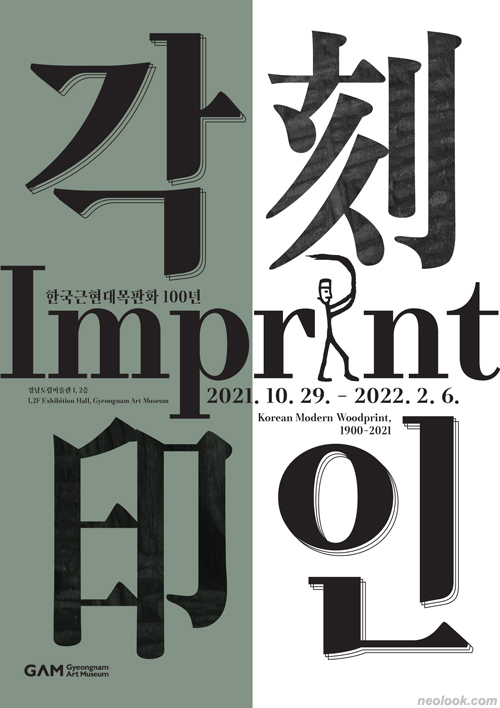- ● homepage
- ● archives
- ● restoration
- ● books
- ● big banners
- ● post board
- ■ neo's search
- ■ about us
- ■ 게재방법 안내
- 개인정보처리방침

- [email protected]
- Tel. 02_335_7922
- Fax. 02_335_7929
- 10:00am~04:30pm
- 월요일~금요일
- 3/3(월) 대체공휴일

각인 刻印-한국현대목판화 100년
Imprint–Korean Modern Woodprint, 1900-2021展 2021_1029 ▶ 2022_0206 / 월요일,1월 1일,설날당일 휴관
별도의 초대일시가 없습니다.
1부 참여작가 / 출판미술목판화, 1950-90년대 모더니즘/민중미술 주요작가
2부 참여작가 / 강경구_김억_김준권_류연복 서상환_안정민_유대수_윤여걸 이윤엽_정비파_정원철_주정이
특별展 / 조선시대 능화판
관람료 성인 1,000원 / 청소년,군인 700원 / 어린이 500원 장애인, 유공자, 65세 이상, 7세 미만 무료 자세한 사항은 ▶ 경남도립미술관 공식 홈페이지 참고
관람시간 / 10:00am~06:00pm / 월요일,1월 1일,설날당일 휴관 ▶ 전시관람 사전예약
경남도립미술관 GYEONGNAM ART MUSEUM 경남 창원시 의창구 용지로 296 1,2층 Tel. +82.(0)55.254.4600 www.gyeongnam.go.kr/gam
우리나라 목판인쇄문화와 목판화 전통은 유구하다. 세계 최초 목판인쇄물인 신라시대의 무구정광대다라니경, 고려시대 팔만대장경, 이후 금속활자의 모태가 되는 목활자로, 또 조선시대엔 부모은중경, 오륜행실도, 대동여지도 등의 목판화에 이르기까지 세계에서 최초이자 가장 높은 수준의 전통을 가지고 있다. 그리고 서적의 삽화, 시전지, 능화판, 떡살, 각종 문양 등 생활에서 매우 다양하게 활용된 인쇄문화이기도 했다. 한마디로 인쇄술과 장식성을 겸비한 시각문화의 중요한 축이었다. 근대기 서구 인쇄술의 유입은 목판문화와 목판화의 자연스런 쇠퇴를 동반했다. 그러나 그런 와중에서도 근대적 매스미디어인 『한성순보』, 『황성신문』, 『대한매일신보』, 『대한민보』 등과 여러 책의 표지화와 삽화를 통한 목판화의 흐름은 계속되었다. 많지는 않지만 '개화'와 '항일'의 시대정신을 담은 이미지들도 생산되었고. 이런 흐름은 해방공간 이후 지금까지도 출판미술목판화로 지속되고 있다.
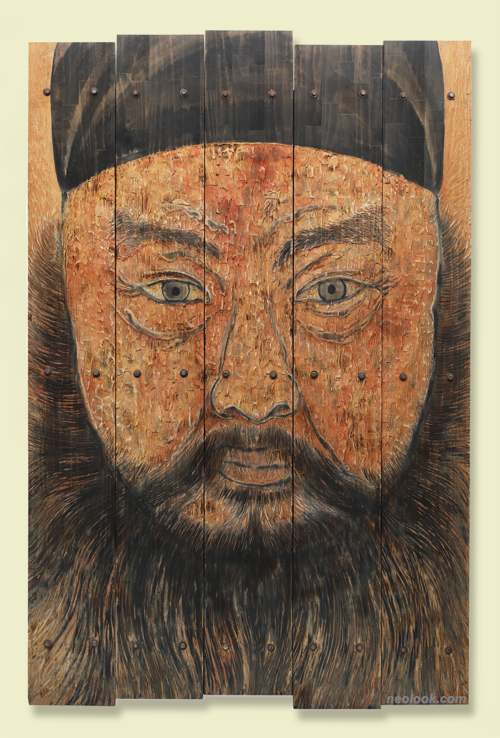
- 강경구_다섯개의 문-공재 윤두서 초상_나무에 판각_230×150cm_1998

- 김억_하동 평사리_한지에 목판_167×276cm_2020

- 김준권_산의노래-2_채묵목판_163×240cm_2021

- 류연복_그리움-바다-2_종이에 다색목판_95×185cm_2020
한국현대판화는 1958년 한국판화가협회의 창립전을 그 기점으로 본다. 화가들에 의한 순수미술 판화가 그 기준이다. 그러나 이미 그 이전에도 출판미술뿐만 아니라 순수미술작품으로도 목판화는 존재했었다. 일제강점기와 해방공간, 그리고 한국전쟁을 거치면서 작품이 유실되고 또 체계적인 기록을 못했을 뿐이다. ● 이번 전시는 근대기부터 지금에 이르는 출판미술목판화와 순수미술목판화를 아우른 20세기 한국 근현대목판화를 1부로 하고, 2000년대 이후 20여 년간 한국현대목판화의 성과를 2부로 설정해 한국근현대목판화 100년의 흐름을 조망한다. 시대적 순서로 나열하자면, 개항기-일제강점기-해방공간-한국전쟁기-1960년대 한국현대목판화 모색기-1970년대 실험기-1980년대 정착기-1990년대 확장기-2000년대 증폭기로 요약할 수 있다.
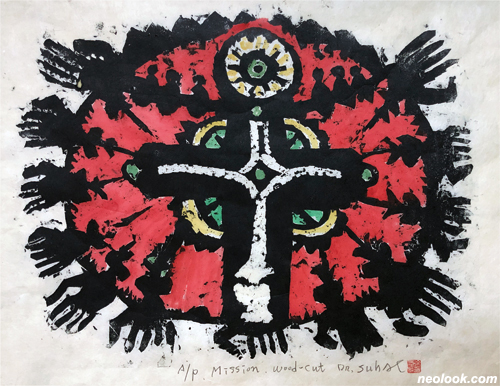
- 서상환_소명 mission_목판화_45×55cm_2020

- 안정민_가로·세로·깊이-海印 21~24_목판, 실리콘캐스팅_244×61cm×4_2011

- 유대수_몽유남천 - 잠시 머물다_ed. 20_한지에 목판_68×135cm_2021
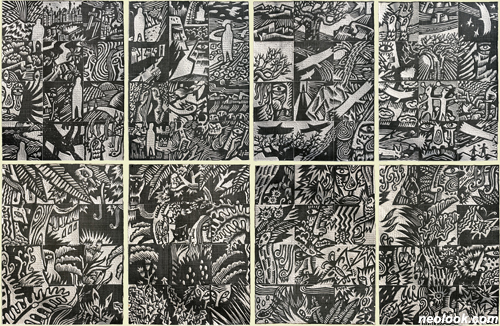
- 윤여걸_갈라파고스_한지, 목판화 릴리프_176×264cm_2016
전시는 1, 2부의 순서에 얽매이지 않고 구성된다. 1, 3전시실은 2000년대 한국을 대표할만한 목판화 작가들의 대형 작품을 중심으로 한국근현대사를 가로지르는 민중의 삶과 공간을 동시에 조망한다. 2전시실은 아카이브 형식(자료전시)으로 구성해 1900년대 이후 출판미술과 1950년대 이후 목판화의 흐름을 확인할 수 있다. 이와는 별도로 2층 특별전시실에서는 조선시대 책표지를 제작하기 위해 사용했던 능화판(한국국학진흥원 제공)전시를 마련해, 근대 이전 인쇄문화를 소개한다. ■ 경남도립미술관

- 이윤엽_대추리에서 세월호까지_목판화_가변크기_2021
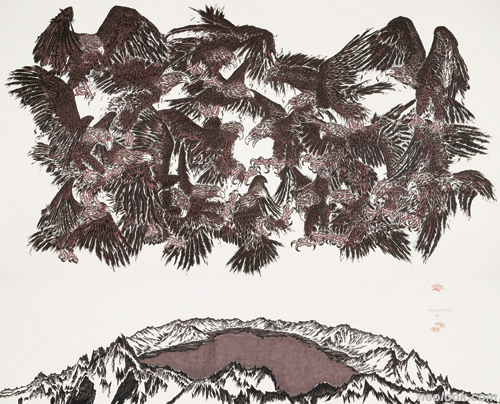
- 정비파_백두산 천지 기운 전도_한지에 아크릴채색, 유성목판_283×369cm_2019

- 정원철_마주보기 face to face_PVC 시트에 리노컷_300×120cm×15_2005

- 주정이_횃불_한지에 잉크_36×15cm_1990
Woodblock printing culture and woodblock prints have long been part of the Korean tradition. From the world's first woodblock prints, the Great Dharani Sutra(Mugujeonggwangdaedaranigyeong) during the Silla period, the Tripitaka Koreana during the Goryeo period, and the moveable wood type that led to the creation of moveable metal type letters, Korea was the world's first woodblock printing nation, the nation with the most advanced printing skills in the world, as demonstrated in the Sutra of Filial Piety, the Oryun Haengsildo(An Illustrated Guide to the Five Moral Imperatives) and the Daedongyeojido(a large-scale map of Korea), in the Joseon era. Printing culture permeated various aspects of Korean life, including book illustrations, writing paper, neunghwapan(book cover printing plates), designs on rice cakes and a diverse range of patterns. It was key for the development and realization of Korea's visual culture and used in both printing technology and decoration. ● The influx of Western printing techniques in modern Korea ushered in the natural decline of woodblock culture and woodblock prints. However, even with the introduction of Western printing techniques, woodblock printing continued in modern mass media in the form of book covers and illustrations, for example Hanseongsunbo, Hwangseong Sinmun, Daehan Maeil Shinbo and Daehanminbo. Small numbers of images displaying the ideas of 'enlightenment' and 'anti-Japanese' sentiment of were also produced. This trend continued after liberation even to the present day, with woodblock prints being used for illustrations and other artworks in various published materials. ● Modern Korean printmaking is considered to have commenced with the inaugural exhibition of the Korean Printmakers Association in 1958 and their fine art prints. Even before that, woodblock prints were used not only in artworks in published materials, but also for fine art prints, however, during Japanese occupation, the period of liberation and the Korean War, no systematic records were kept and many of them were lost. ● The first part of this exhibition focuses on modern woodblock prints in 20th century Korea and includes woodblock prints from various publications, and fine art woodblock prints from the modern to the present era. The second part of the exhibition showcases achievements in contemporary Korean woodcut printing over the last 20 years, beginning in the year 2000 and looks at the role of modern- and present-day woodblock prints in Korea over the last 100 years. Briefly listed in order, these periods are the latter half of the 19th century – the period of Japanese occupation – the liberation years – the Korean War years – the rediscovery of modern Korean woodblock prints in the 1960s – the experimental period in the 1970s – the period of establishment in the 1980s – the period of expansion in the 1990s – the period of development in the 2000s. ● The exhibition does not present works strictly in accordance with Parts 1 and 2. Gallery 1 and 3 showcase a cross-section of both the lives and spaces of people in modern and contemporary Korean history, focusing on large-scale works of leading Korean woodprint artists in the 2000s. Gallery 2 contains an archival exhibition(featuring a variety information and resources) that showcases the trends in art in publications after the 1900s and woodblock prints after the 1950s. In addition, in the Extra Gallery, there is a separate exhibition that provides an insight into pre-modern printing culture and also displays the neunghwapan that were used to make book covers during the Joseon Dynasty(provided by The Korean Studies Institute). ■ GYEONGNAM ART MUSEUM
Vol.20211029d | 각인 刻印-한국현대목판화 100년展

